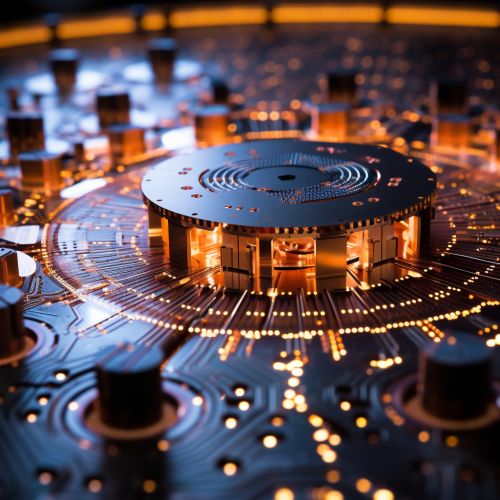Superconducting circuit
Introduction
A superconducting circuit is a type of electronic circuit that utilizes superconducting materials to carry electric current. These circuits are characterized by their ability to conduct electric current without any resistance when cooled below a certain critical temperature. This unique property of superconductors has led to their widespread use in a variety of applications, including quantum computing, magnetic resonance imaging (MRI), and particle accelerators.


Superconductivity
Superconductivity is a quantum mechanical phenomenon where certain materials exhibit zero electrical resistance and expulsion of magnetic fields when cooled below a critical temperature. This phenomenon was first discovered by Heike Kamerlingh Onnes in 1911, who observed that the resistance of mercury dropped suddenly to zero at a temperature of approximately 4.2 Kelvin.
The theoretical understanding of superconductivity was greatly advanced by the development of the Bardeen–Cooper–Schrieffer (BCS) theory in 1957. This theory describes superconductivity as a state in which electrons form pairs, known as Cooper pairs, that move through the lattice of positive ions in the material without scattering off impurities or lattice vibrations, thus experiencing no resistance.
Superconducting Circuits
Superconducting circuits are electronic circuits made from superconducting materials. These circuits can carry electric current without any resistance, making them highly efficient and ideal for applications that require high precision and low power consumption.
The most common type of superconducting circuit is the Josephson junction, which consists of two superconductors separated by a thin insulating barrier. This junction exhibits a number of unique quantum mechanical effects, including the Josephson effect, where a current can flow across the junction without any applied voltage, and the AC Josephson effect, where an applied voltage causes an oscillating current.
Applications of Superconducting Circuits
Superconducting circuits have a wide range of applications, thanks to their unique properties.
Quantum Computing
In quantum computing, superconducting circuits are used to create qubits, the basic units of quantum information. These qubits are often based on the Josephson junction and can exist in a superposition of states, allowing for the parallel processing of information. This makes quantum computers potentially far more powerful than classical computers for certain tasks.
Magnetic Resonance Imaging
Superconducting circuits are also used in Magnetic Resonance Imaging (MRI). The superconducting magnets used in MRI machines generate a strong and stable magnetic field, which is necessary for producing high-resolution images.
Particle Accelerators
In particle accelerators, superconducting circuits are used to create powerful magnetic fields to accelerate charged particles to high speeds. The Large Hadron Collider (LHC) at CERN, for example, uses superconducting magnets to steer particles around its 27-kilometer circumference.
Challenges and Future Directions
Despite the many advantages of superconducting circuits, there are also several challenges that need to be overcome. One of the main challenges is the need for low temperatures, as superconductivity only occurs below a certain critical temperature. This requires the use of cryogenic cooling, which can be expensive and complex.
Furthermore, superconducting circuits are sensitive to external magnetic fields and radiation, which can cause noise and errors in the circuit. This is a particular challenge in quantum computing, where maintaining the quantum state of qubits is crucial.
Looking to the future, research is ongoing to develop new superconducting materials with higher critical temperatures, as well as techniques to reduce noise and improve the stability of superconducting circuits. These advances could open up new possibilities for the use of superconducting circuits in a wide range of applications.
